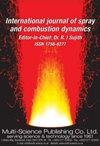Measurements in swirling spray flames at blow-off
IF 2.1
4区 工程技术
Q3 ENGINEERING, MECHANICAL
International Journal of Spray and Combustion Dynamics
Pub Date : 2018-03-23
DOI:10.1177/1756827718763559
引用次数: 27
Abstract
Various characteristics of swirling spray flames of ethanol, n-heptane, n-decane, and n-dodecane have been measured at conditions far from and close to blow-off using phase Doppler anemometry and OH* chemiluminescence, OH-planar laser-induced fluorescence, and Mie scattering at 5 kHz. The blow-off transient has also been examined. The OH* showed that the two main heat release regions lie around the spray jet at the inner recirculation zone and along the outer shear layer between the inner recirculation zone and the annular air jet. The heat release region is shortened and more attached as the flame approached blow-off. Mie images and phase Doppler anemometry data showed a wider dispersion of the ethanol spray compared to the other fuels. Similar spatial distributions of the Sauter mean diameter were observed for the four fuels for identical flow conditions, with the Sauter mean diameter value increasing with decreasing fuel volatility, but with the exception of significant presence of droplets in the nominally hollow cone for the ethanol spray. The OH-planar laser-induced fluorescence measurements showed an intermittent lift-off from the corner of the bluff body and the average lift-off height decreased with increasing air velocity, with less extinction along the inner flame branch especially for the heavier fuels. At the blow-off conditions, local extinctions appeared at both flame branches. The blow-off process followed a gradual reduction of the size of the flame, with the less volatile fuels showing a more severe flame area reduction compared to the condition far from blow-off. The average blow-off duration, τ ext , calculated from the evolution of the area-integrated OH* signal, was a few tens of milliseconds and for all conditions investigated the ratio τ ext /(D/UB) was around 11, but with large scatter. The measurements provide useful information for validation of combustion models focusing on local and global extinction.吹出时旋涡喷射火焰的测量
采用相位多普勒风速法、OH*化学发光法、OH平面激光诱导荧光法和5 kHz Mie散射法测量了乙醇、正庚烷、正癸烷和正十二烷在远离和接近吹灭条件下的旋流喷雾火焰的各种特性。还对吹脱瞬态进行了研究。OH*表明,两个主要的放热区位于内再循环区喷雾射流周围和内再循环区与环形空气射流之间的外剪切层。当火焰接近吹灭时,放热区域缩短且更加附着。Mie图像和相位多普勒风速测量数据显示,与其他燃料相比,乙醇喷雾的分散范围更广。在相同的流动条件下,四种燃料的Sauter平均直径的空间分布相似,Sauter平均直径值随着燃料挥发性的降低而增加,但乙醇喷雾的名义空心锥体中存在明显的液滴。oh平面激光诱导荧光测量结果表明,随着空气速度的增加,钝体的角部有间歇性的上升,平均上升高度减小,沿内火焰分支的消光较小,特别是对于较重的燃料。在吹灭条件下,两个火焰分支都出现了局部灭绝。吹灭过程是随着火焰大小的逐渐减小而进行的,与远离吹灭的条件相比,挥发性较低的燃料显示出更严重的火焰面积减小。根据面积积分OH*信号的演化计算,平均吹灭时间τ ext为几十毫秒,在所有研究条件下,比值τ ext /(D/UB)约为11,但散点较大。这些测量结果为验证聚焦于局部和全局灭绝的燃烧模型提供了有用的信息。
本文章由计算机程序翻译,如有差异,请以英文原文为准。
求助全文
约1分钟内获得全文
求助全文
来源期刊

International Journal of Spray and Combustion Dynamics
THERMODYNAMICS-ENGINEERING, MECHANICAL
CiteScore
2.20
自引率
12.50%
发文量
21
审稿时长
>12 weeks
期刊介绍:
International Journal of Spray and Combustion Dynamics is a peer-reviewed open access journal on fundamental and applied research in combustion and spray dynamics. Fundamental topics include advances in understanding unsteady combustion, combustion instability and noise, flame-acoustic interaction and its active and passive control, duct acoustics...
 求助内容:
求助内容: 应助结果提醒方式:
应助结果提醒方式:


